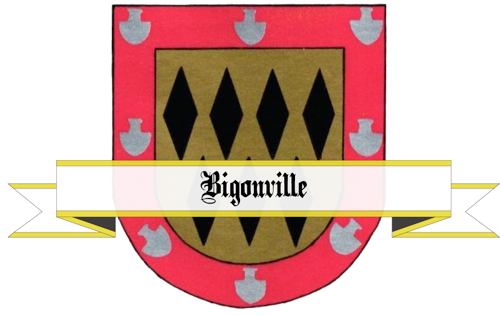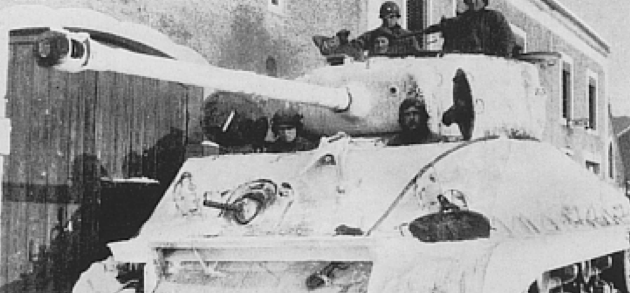Reports of the liberation of Bondorf, Luxembourg
by John A. Whitehill, DSC
Activities of Company "A" 37th Tank Battalion, Fourth Armored Division, 3rd US Army December 23-25, 1944 - Flatzbourhof - Bigonville, Luxembourg
The 37th Tank Battalion of the Fourth Armored Division assigned to Combat Command Reserve on 22 December 1944 was located two miles North of Arlon, Belgium. At approximately 2300 orders were received from CCR that the objective for the following day would be Bigonville.
Company "A" was commanded by then 2nd Lt. John A. Whitehill, Company "B" led by Captain James H. Leach and Company "C" under the leadership of Captain Charles Trover composed the officers in charge of the medium tanks on this occasion.
The order of march was RCN/37, B/37, B/53, HQ/37, A/37, C/37, AIB/53, and the 94th AFA. The route of march was North, then East to Perle, Holtze, Flatzbourhoff. The icy roads hampered movement of the tanks and half-tracks causing delay in the column reaching the outpost of the 25th Cavalry just beyond Holtze. This move was made under radio silence until such a time as B company was just south of Flatzbourhoff crossing. They received small arms fire, mortar and some direct AT fire. Enemy infantry with white capes and helmets were observed. Orders were issued by the Battalion Commander for the attack. Tanks were to attack cross country with infantry mounted on the tanks and their remainder mounted in half-tracks. Artillery preparations were laid on the woods and possible anti-tank positions.
Just short of the road and rail crossings B Company observed in the over one foot of virgin snow tracks made by German tanks. Word was received from likely Army liaison aircraft that enemy contact was imminent. B Company attacked in a line formation to cover a broader frontage. Several of their tank commanders were either killed or wounded and the forward advance was halted. A Sherman tank being utilized by the Germans was destroyed.
When Company B was detained by enemy fire at this railroad crossing, Lt. Col. Creighton Abrams, the Battalion commander, ordered Company A to pass through and resume the attack and maintain the assault momentum. Company A moved to the RR crossing area with Lt. Whitehill in the lead tank. This tank was disabled by a mine which removed a three to four foot long section of track, one bogey wheel and caved in the bottom of the tank injuring the tank driver. At the time of impact it was difficult to determine whether it was an HE shell contact or was it a mine. S/Sgt. Herman Walling was in the following tank and identified by observation that it was indeed a mine. Lt. Whitehill immediately assumed command of the sergeants tank and he in turn took over the damaged tank and wounded crew. It was impossible to know the extent of the mined area due to the fact of over 12 inches of unbroken snow coverage.
Lt. Whitehill then maneuvered his recently acquired command tank back the road of approach and skirted the potential mined area and moved along a fence row to the east of this road to Bigonville and North to the RR tracks adjacent to the rail wayside station. The remainder of Company "A" deployed in a line formation North of the tracks facing Northerly toward Bigonville. At this time the Company came under direct fire from a ridge NW of Bigonville. Lt. Whitehill's tank received three direct hits on the turret with armor piercing shells, none of which entered the tank, however, the loader received rib cage injuries and the driver received an arm injury when one of the shells opened his hatch and cut his arm. The crew, less Lt. Whitehill, evacuated the tank and moved to the rear. Lt. Whitehill discovered that the tank would still operate and drove it to the rear and turned it over to the wounded crew for their transportation to the medics.
During this period of time another tank in Company "A" was also hit with enemy direct fire and wounded the officer in command. Lt. Robert Gilson was only with the Company for approximately three weeks having arrived through the replacement system. This now left only one officer, Lt. Whitehill, in the Company vs the regular staff of five. It was unusual that the only tanks that were hit by enemy fire at this time were the two occupied by the only officers in the company.
Lt. Whitehill having lost two of his personal tanks from under him within a twenty minute time frame elected to lead the assault the remainder of the day on foot using hand and arm signals or by using the radio of S/Sgt Ralph Rowland's tank while riding on the rear deck. Available tanks were at a premium and he didn't want to reduce effective fire power while leading the entire Company alone. Company "A" now moved under cover of darkness through the now nearly two feet of unbroken snow to establish a road block on the road leading Westward out of Bigonville. Tanks were deployed in a wooded area NW of Flatzbourhof and the South of the road running West out of Kimm towards Martelange. The two tanks that Lt. Whitehill lost were the third and fourth that he lost since joining the company in October'44.
Company "C" under command of Captain Charles Trover moved his company East along side Company "A" on the road to Kimm. It was at this time Captain Trover was killed by sniper fire while standing in the turret of his tank. The Battalion secured for the night, not reaching the planned goal of Bigonville by night fall. Confusion and casualties led to securing and to consolidate and resume the attack toward Bigonville at first light on 24 December.
24 December 1944 - Lt. Col. C. Abrams met with his staff and line company commanders in the Battalion CP during the early hours to confirm the attack plan on Bigonville. At 0800 hours Co. "B" was to assault the village from the Southwest cross country with Co. "A" to move into town using the roadway entering from the South.
Co. "B" encountered heavy opposition and when forward movement ceased Col. Abrams ordered Co. "A" to push into the village as planned to sustain the drive. Co. "A" moved into Bigonville along the highway in a NE direction. Co. "A" now had only nine tanks in operation at this time. S/Sgt F. Woods led the first platoon of four tanks into the attack. S/Sgt. Ralph Rowland moved his platoon of four tanks on the left side of the company's wedge formation to cover the area between Co. "A" and "B" Company to cover our left flank and prevent enemy troops from escaping from the village. S/Sgt Woods was held up by mortar, machine gun and Panzerfaust fire stalling the battle attack. Lt. Whitehill at this time moved to the head of the attack and entered the village. Co. "A" worked the village until mid day when it was declared clear and final security at 2200 hours. Co. "A" outposted the village on the high ground NE of the village while Co. "B" was posted on the NW comer of town. During the encounter S/Sgt Woods tank sustained a direct hit in the track and bogey wheel area but the vehicle was not put out of action at this time. The Armored Infantry ( Co. "A" 53rd ) lost their leadership during the clearing of the village and the remaining troops were directed in their activities by Lt. Whitehill.
Captain Leach and Lt. Robert Cook were wounded during the battle. Lt. Cook received a chest wound while Captain Leach was wounded in the head.
During the siege of Bigonville over 400 German prisoners were taken captive, numerous enemy were wounded and 30 American officers and men were rescued. These American troops were treated as enemies until cleared after questioning because during the onslaught of the Germans many enemy troops were dressed as Americans in this area and trust had to be established before setting them free. These men were taken prisoners when the Germans were in the process of surrounding Bastogne.
An incident of personal nature and interest to me was when I was leading my company through the village forward progress ceased while my personal tank was located beside a barn along the main street. I could see shadows of German soldiers cast upon the street in front of my tank. The shadows of Panzerfausts were also seen. While I was determining what action to take Col Abrams asked me on the radio, " why the attack was not moving forward as planned," and I related the situation and he immediately countered with a verbal lesson in tactics which covered direct fire verses high trajectory fire. He also covered tank movement usually could move against foot soldiers. Capt. John McMahon, Battalion S-2, entered the conversation without any radio identification and stated," If Whitehill could move he would." Capt. McMahon was task force "A" liaison between the attack companies and the Battalion on this mission. These comments motivated me so the barn was set afire with a grenade to chase the enemy away so we could move forward without being under fire by Panzerfaust shells.
During the above time frame a sniper was firing at me as I stood in the turret. His shells were flaking paint from the turret in my eyes as I peered out of the open hatch. I was saving tank ammunition and tried to silence the sniper with machine gun fire with my sub machine gun and as I raised my hand out of the hatch area he wounded me in the right hand. This wound was to be my third wound of four that I received during WW II. After being hit in the hand we laid the tank gun on the sniper area position and with a round of 75 MM HE cleared the street and proceeded through the village.
About midnight on 24 December, Col Abrams assembled his company commanders to a meeting at his command post South of Bigonville at Kimm and we were ordered to immediately move from this area across the rear of CCA and CCB to a new attack area at Vaux-les Rosiers, Belgium. At approximately 0030 25 December the new move was started and the 26th Infantry was to assume the Bigonville zone.
The 4th Armored Division, 37th Tank Battalion moved into contact with the enemy at Nives and started the move Northward at daybreak to liberate the 101st Airborne at Bastogne.
John A. Whitehill 12 August 1985
30 December 1997 (Revision # 1)


